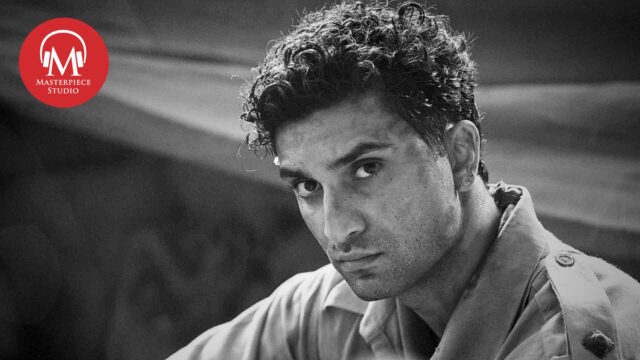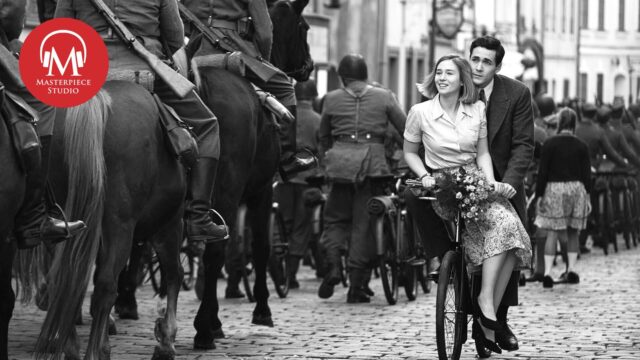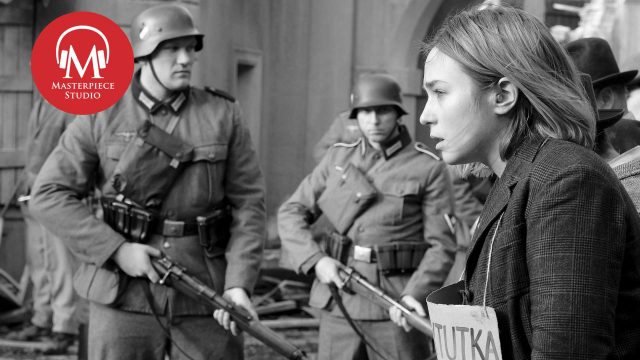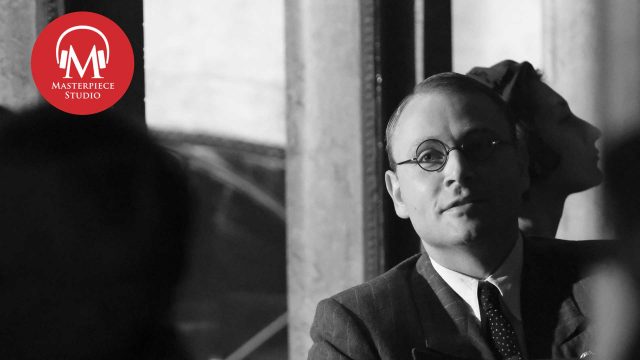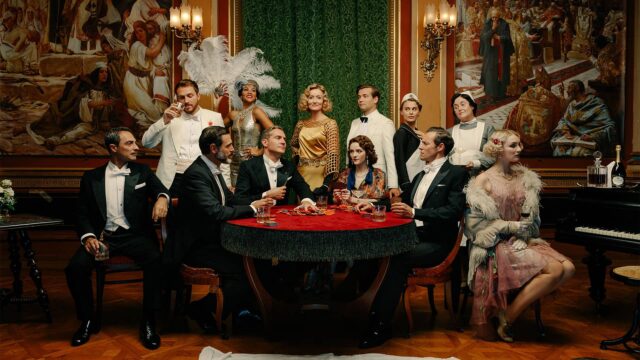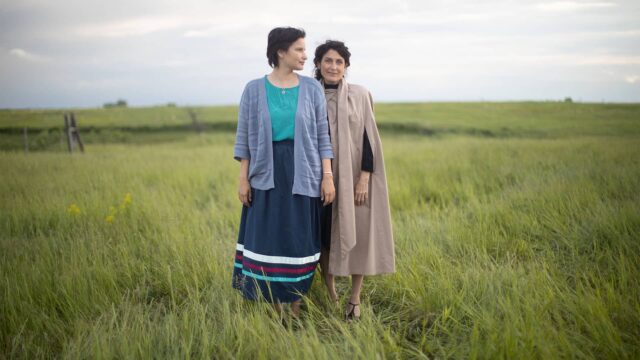Jace Lacob: I’m Jace Lacob, and you’re listening to MASTERPIECE Studio.
October, 1940. Manchester, England is under attack by two Luftwaffe planes, which bomb the city in the dead of night, forcing the Royal Air Force to take to the skies. RAF pilots David, played by Gregg Sulkin, and Shortbread, played by Geraint Downing, do their best to protect King and Country, but the thick Manchester fog makes it impossible to see their enemies clearly. Shortbread eventually shoots down one of the German bombers, but David is ambushed from behind.
CLIP
Shortbread: We should return to base.
David: Without bagging a pair? Fat chance.
Shortbread: On your tail!
(Shooting SFX)
David: I’m hit! I’m hit!
Shortbread: Bail! Bail!
David: I’m trying! The canopy is stuck.
On the ground below, Harry and Kasia arrive at Robina’s house, where Kasia and Jan reunite for the first time since the start of the war. This is also the first time Kasia and Robina come face to face, and Kasia receives a…well…classic Robina greeting.
CLIP
Robina: I must say, I thought Polish women to be rather, oh I don’t know, bovine. But you’re actually, really quite beautiful.
Kasia: Thank you.
This season on World on Fire, the action swings to the Egyptian desert where the British Army prepares to hold off the Italians and Axis powers from gaining further ground. And it is here that we meet the British Indian Army, led by Second Lieutenant Rajib Sal, played by Ahad Raza Mir. Rajib is head of a Sapper unit, responsible for defusing landmines for the British Army — a task not for the faint of heart, or shaky of hand.
CLIP
Stan: Now as you can see, the road is a damn sight clearer on this map than it is out there so we will be following their tracks. You will be leaving tracks, won’t you lieutenant?
Rajib: Oh yes. Or a large smoking crater if we don’t do our job properly.
One element that makes World on Fire such a gripping drama is how closely its plot follows the real-life history of World War II. And because so much happened in that first year of the war — and because there’s a time jump of a few months before this first episode back — we want to take a moment to get oriented.
If you’re confused about the North African campaign, never ending bombings in Manchester, or the U.S’s non-involvement, don’t fret. We here at MASTERPIECE Studio have got you covered. Let us bring you up to speed about everything in Episode 1.
Season 2 of World on Fire begins in October, 1940. But in order to really understand what was going on, we need to jump back to 1930s Germany. One of the most horrific events of World War II was the genocide of European Jews, known as the Holocaust. We can trace its origins back to 1933 when Adolf Hitler became Chancellor of Germany. Throughout the 1930s, he instituted many antisemitic policies that isolated and harassed Germany’s Jewish population.
Beginning the evening of November 9th, 1938, the German government, military, and private citizens vandalized Jewish businesses, homes, schools, hospitals, and synagogues all over the country. They burned buildings, smashed storefronts, and terrorized Jewish neighborhoods. This became known as Kristallnacht, or “night of broken glass.”
An estimated 91 Jews were killed, and 30,000 Jewish men were sent to Nazi concentration camps in Germany. But this was just the beginning. Over the course of the war, millions of Jews, prisoners of war, gays and lesbians, Romanies, and elderly and disabled people would be sent to concentration camps and or murdered. Here’s historian Richard Overy, who serves as World on Fire’s historical advisor.
Richard Overy: Since Kristallnacht, a great effort had been made by the Germans to expel their Jews. The real problem is that most of the countries that they thought would accept them, like Britain and the United States, put up all kinds of barriers. So more and more Jews, of course, were, in effect, trapped in Nazi Europe. The plan was to ghettoize them. The hope was that the ghettos would also take a toll on the Jewish population through illness and malnutrition. But this is not yet the genocide. That unfolds slowly during the course of 1941.
Jace Lacob: How much of what was going on in Germany, in Poland, was known in 1940 in Britain then at that point, before the concentration camps?
Richard Overy: Well, remarkably little, actually. Remarkably little. There were avenues for getting information and intelligence. But it was very hard to pin together what was going on in the East, very hard to pin together what was going on in Poland. It’s only later, 1941 and 1942 that they begin to get firmer evidence about what’s happening, not that it actually encourages them to do very much. But in 1940, the British focus is on saving Britain. They’re less interested in what’s going on in Eastern Europe.
As Season 2 of World on Fire begins, Nazi Germany has invaded the vast majority of Europe. Many countries are either occupied or have been completely absorbed by the Third Reich. But Britain still manages to resist Hitler and the Nazis.
However, the future looks even more bleak because a few months earlier in June of 1940, Italy joined the war and sided with Germany. Then on September 27, 1940, Germany, Japan, and Italy signed the Tripartite Pact, uniting the three countries into the Axis powers. Now with a formalized alliance, they could quite literally divide and conquer. And this brings us to one of the main settings in this season of World on Fire, the deserts of North Africa.
Jace Lacob: Can you set the stage and explain what the stakes are for what’s happening in North Africa as episode one opens? What were the Italians trying to accomplish? And what were the British setting out to do?
Richard Overy: This is an Italian campaign. This is where the Italians are fighting their war effort. Italy declared war on Britain and France in June of 1940, right at the end of the German defeat of France. And Mussolini has a grand vision now of building an empire in the Mediterranean and Northeast Africa. So the fact that the Italian army is there is to feed Mussolini’s fantasy of reconstructing a kind of second Roman Empire. And it is a fantasy. But that’s why they’re there, and that’s what he wants to do. And he tells the commander in North Africa, Graziani, to move into Egypt with a view of moving on to Cairo and Alexandria.
Well, the British, of course, are extremely worried about this, because they think that it will threaten the Suez Canal at the time. They think it will threaten the route to India. It might roll up the whole of the British Empire in the Middle East and East Africa and so on.
Here’s Sir James, played by Mark Bonnar, a character you’ll meet in Episode Two, explaining the situation to Jan using maps and figurines. In this clip, Sir James mentions the German field marshal Erwin Rommel, who, in real life, won’t enter the war until the following year.
CLIP
Sir James: Rommel’s goal is Cairo, and the Suez Canal. Now, the Suez Canal connects us to the East. Now, if Rommel manages to take the Suez Canal, he effectively cuts the British Empire in half.
Richard Overy: So, Churchill, who’s a great imperialist and whose vision of the war is an imperial one, it’s very important that they obstruct the Italians, that they destroy Mussolini’s fantasy. There is a lot at stake. There’s a lot at stake for Mussolini, his reputation, and the Italian Empire is at stake. For the British too, they think the British Empire is at stake, and the Suez Canal, and the Middle Eastern oil. And that’s why they’re battling away there.
Jace Lacob: The Americans from season one are gone, Europe, it seems, is on its own as the bombing of Pearl Harbor has yet to draw the United States into the global conflict, and Roosevelt promises not to send “our boys” to war. Why was America so intent on pursuing an isolationist policy at this point?
Richard Overy: Well, I think for Roosevelt, it’s a question of his own political survival. Hostility to the idea of going to war is widespread in American society. Gallup polls show overwhelming majorities against the idea of joining the war while they also show, of course, very big majorities in favor of supporting Britain if possible, being sympathetic to Britain.
But there’s a widespread feeling in America that Europe and Asia, they’re in a mess. They’re in their own mess that we don’t want American boys to die again in that kind of mess as they’d done in the First World War. It takes a lot, it takes Pearl Harbor in the end, to shift American opinion, to make most Americans realize that this is a conflict they cannot in the end stay out of.
Wondering whether Lebensborn was real or an invention for World on Fire? We’ll take a quick break and when we return, Richard Overy will help shed light on what’s historical fact and what’s dramatic fiction in episode 1.
MIDROLL
Jace Lacob: One of the more fantastical elements of the season on World on Fire, certainly for the modern audience, is the notion of the Lebensborn or Fount of Life. What was the underlying philosophy behind Lebensborn and how widespread were these repopulation practices in Nazi Germany? What was its ultimate goal?
Richard Overy: Well, the ultimate goal, of course, was to try and multiply the number of ethnic Germans. And it went hand in hand, in fact, with a program initiated by Heinrich Himmler, head of the SS, and the man that, in October 1939, Hitler made responsible for racial questions. And Himmler thought you could comb through Poland later on, after Barbarossa, Ukraine as well, looking for blue eyed blonde people, and seeing whether it was possible to Germanize them. And they did do that. They rounded up kids, took them back to Germany, hoped that they could make them into true blood Germans.
So, the obsession was really to create a pure race, and if possible, to keep it pure and to expand it. Hitler’s and Himmler’s vision really is in the end of a huge German population. Himmler is thinking of 600 million Germans inhabiting Europe and Eurasia—an extraordinary vision given that there were only 90 odd million Germans in 1940. And the Lebensborn program is bound up with that, trying to identify pure Aryan young women, getting them to bear children for the fatherland. And these children would also become the bearers of the race, if you like. The idea is that it would help to sustain the racial fantasy that drove Himmler and the other racists around Hitler.
Jace Lacob: Marga seems especially primed to participate in the undertaking that you’re describing. Was it viewed as the ultimate honor for young women or was it viewed with horror?
Richard Overy: Well, actually, it was not well known, of course. I mean, the idea was that it would be kept secret within the SS. But, of course, there were idealistic young women and young men, willing to participate in this racial fantasy. From that point of view, World on Fire has captured a particular moment in the history of the Third Reich, a particular moment when that idealism flourished. Very soon, of course, as the war turned sour, much of that idealism disappeared.
Jace Lacob: American viewers, in thinking about wartime bombings in Britain during the war, tend to think about the London Blitz. How significantly were Manchester, Liverpool, and other northern cities bombed during 1940?
Richard Overy: Well, most of the bombing was, in fact, concentrated on London in the first months of the Blitz. And indeed for an American audience, they made a film, London Can Take It, which was sent to American cinemas, which focused entirely on London. When they showed it in Britain, there were wide protests because other places said, we’ve been bombed too. But actually places like Manchester, Liverpool, Cardiff, Hull, systematic bombing really only began in December, January 1940, 41.
And the idea was to blockade Britain. Most of the bombing was on ports, including the port of London. And Manchester was an internal port, if you like, linked to the sea. And the idea was to destroy stocks of food, mills producing flour, warehouses, oil refineries and so on. And so the pattern of bombing from December 1940 onwards is really blockade bombing, and 80%, 90% of the bombing is actually on port areas. And Manchester is on that list, and it was hit dramatically in December 1940. And very large numbers of warehouses and other storage facilities are hit at the same time, of course, as residential houses.
Jace Lacob: We see significant evidence of xenophobia towards refugees, which comes to a head with Kasia punching the man in the cafe in episode one.
CLIP
Englishman: My son’s out there fighting for you lot. What are you doing?
Grzegorz: I was at Dunkirk, sir, and we have nothing but respect—
Kasia: And I killed more Nazis than you ever will sitting here on your fat bottom spouting nonsense!
Englishman: You need to control her lad. Else, me and you will sort this outside. Scum of the Earth we’re letting into this country.
Kasia: Scum of the Earth has been saving your country!
(Kasia punches Englishman)
Jace Lacob: What were attitudes toward eastern European refugees at the time, particularly in the north of England?
Richard Overy: I think that this is probably not typical, in fact. There was a great effort made to extend friendship to refugees. There were some exceptions. There was quite a lot of hostility, oddly enough, to Belgian refugees when they came over after the German invasion of Belgium, for reasons that’re not entirely clear. But there were many refugees, of course, and a great number of them were Jewish, and a great deal of sympathy and welfare help went out to the Jewish community.
The problem was the government. The government decided that foreigners, particularly Germans, posed a risk. And although we don’t deal with this in World on Fire, of course, in the summer of 1940, they were all rounded up and put in factory concentration camps in the United Kingdom.
Jace Lacob: Wow. That is, I feel like something that is not usually discussed.
Richard Overy: It’s not, no. I mean it’s something that doesn’t enter the British narrative of the war, because it’s not a very pleasant experience. But Churchill was soon made to change his mind and they gradually began to release almost all of the Jewish prisoners, and German and Italian prisoners as well. They were keeping only a very small number who were suspect. But that was a black point against Britain. But I think that otherwise the reaction, I think, to having refugees was a relatively positive one.
Jace Lacob: Richard Overy, thank you so very much.
Richard Overy: My pleasure.
World on Fire historical advisor Richard Overy will join us at the end of each episode of MASTERPIECE Studio this season for more historical commentary. Keep listening for more insights into what’s historical fact and what’s dramatic fiction.
In two weeks, life in the desert pushes some of the Allied forces to drastic measures.
CLIP
Stan: Just to be clear, sir, we’ve got no bullets in our guns and you suggest we nick a Jeep off two Germans?
Rajib: We have no food, no water. I’d rather a quick death than a slow one.
Stan: I’d rather not die at all.
Director Meenu Gaur joins us on October 29th to discuss how her background and aesthetic choices amplify the drama in this season of World on Fire.

















